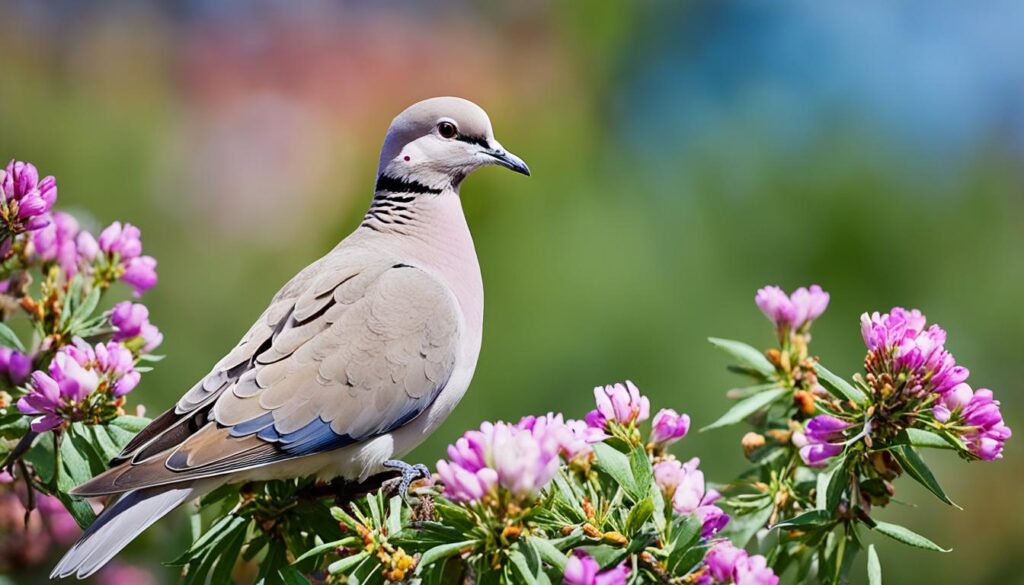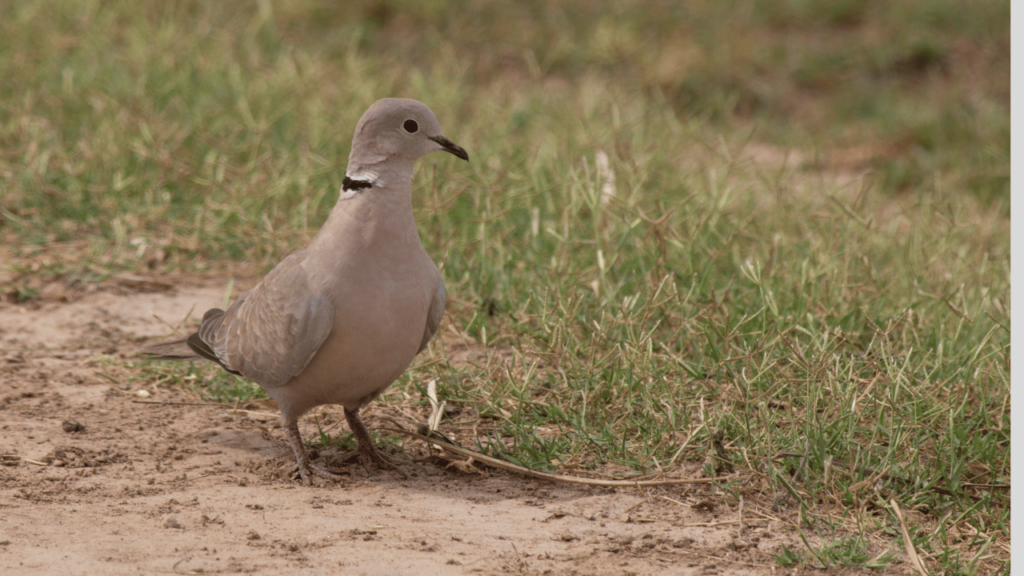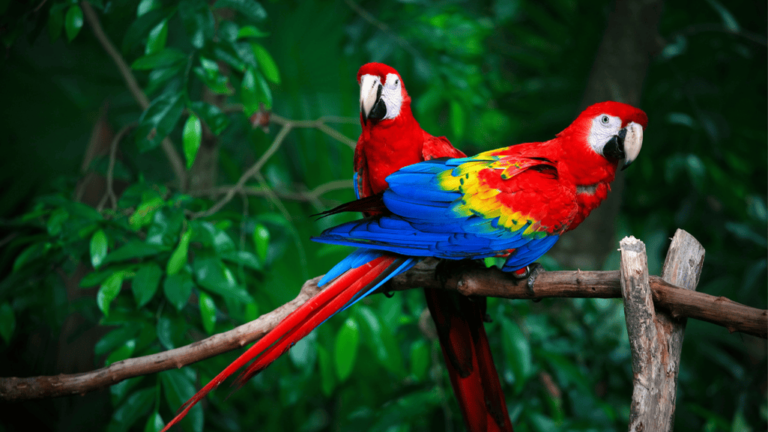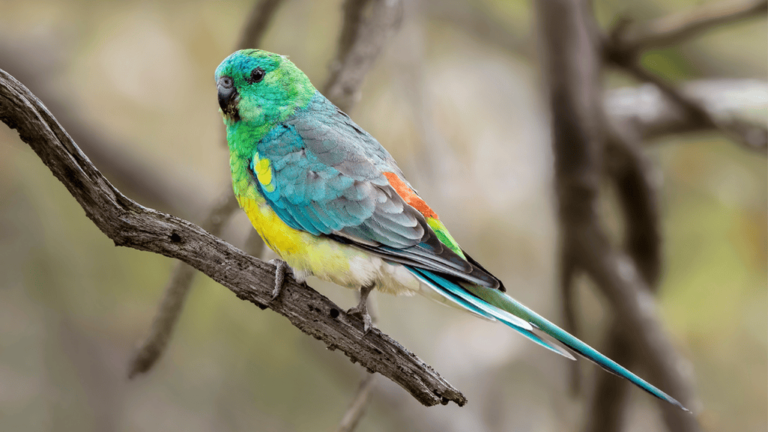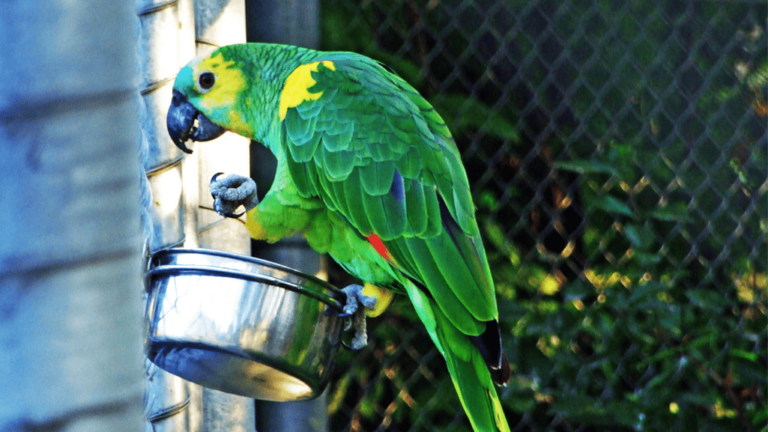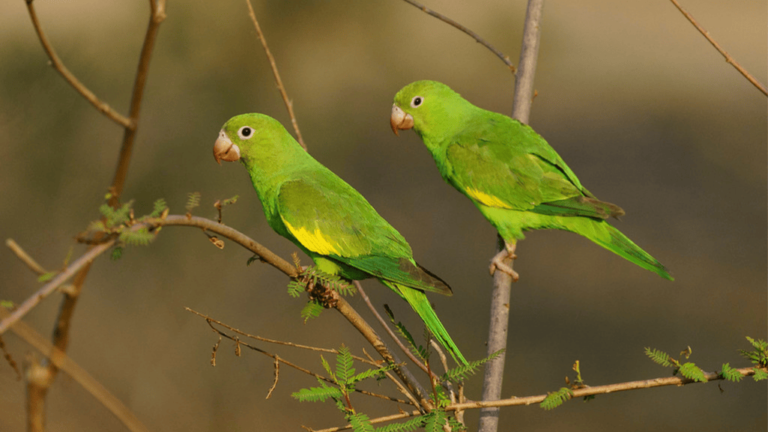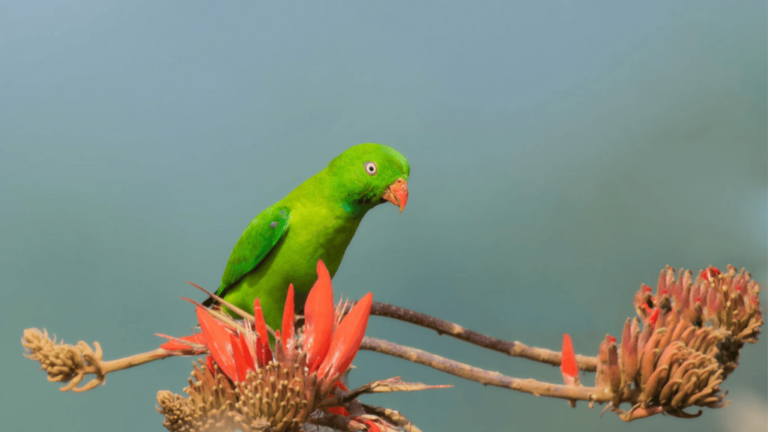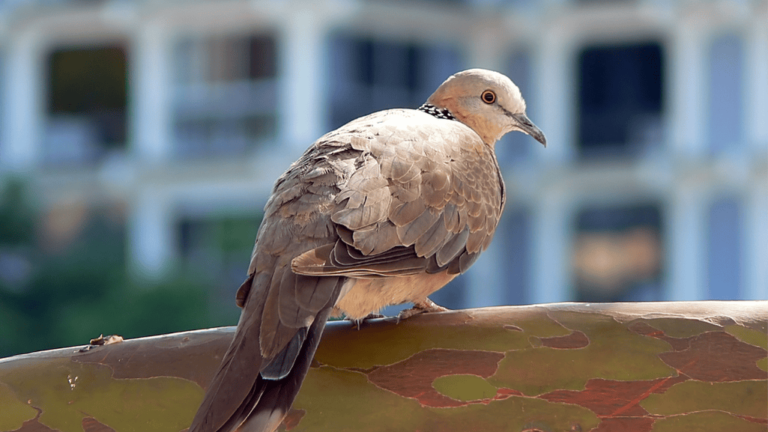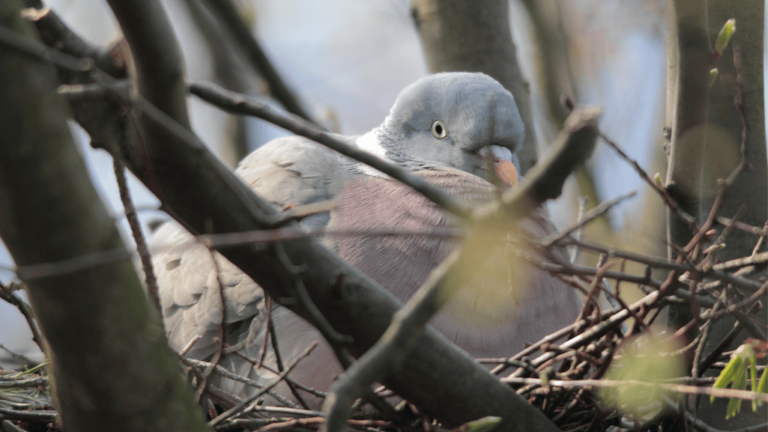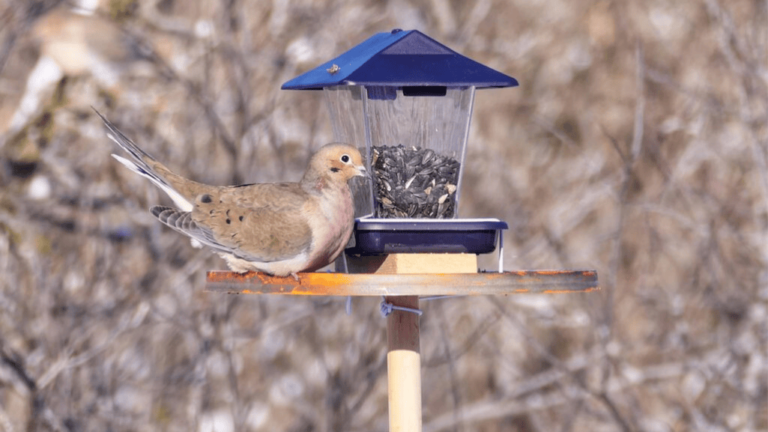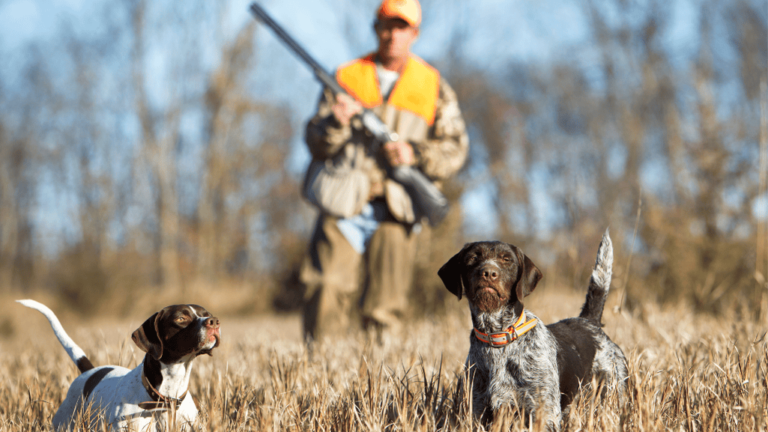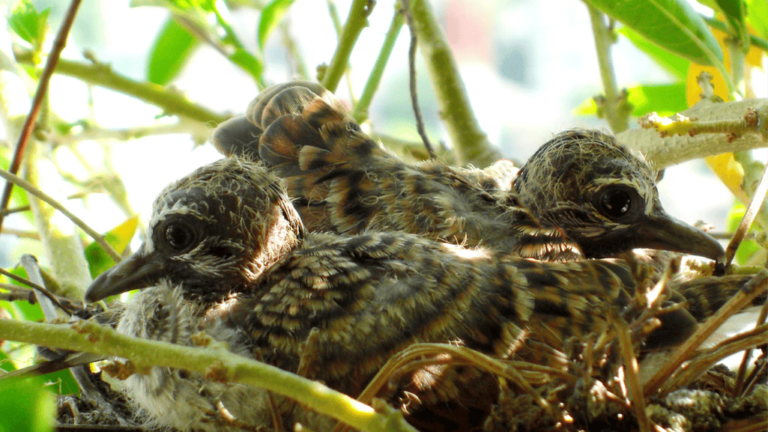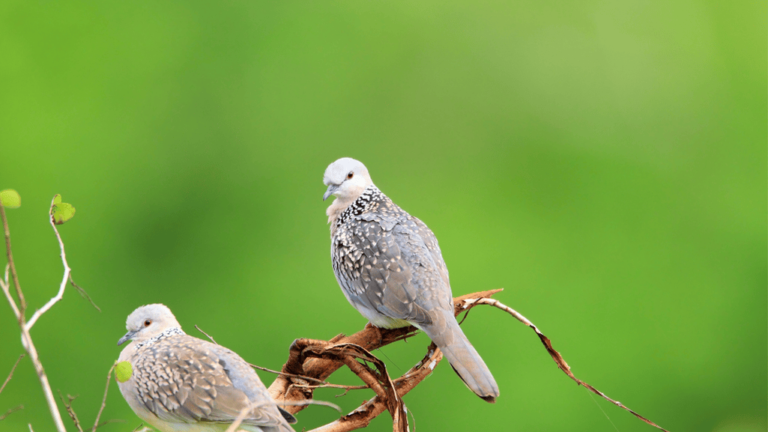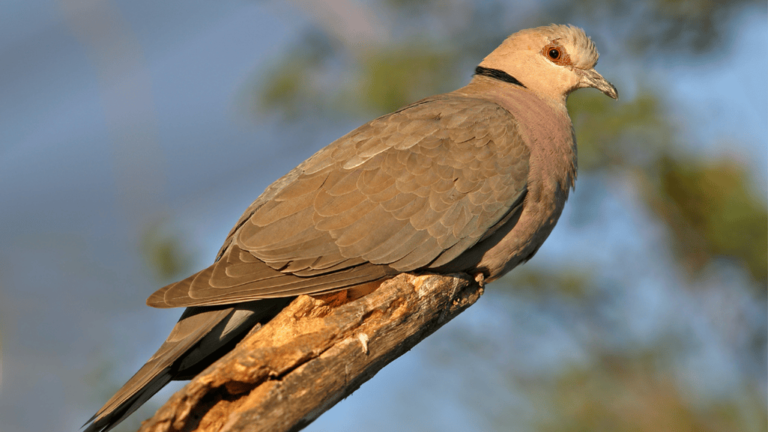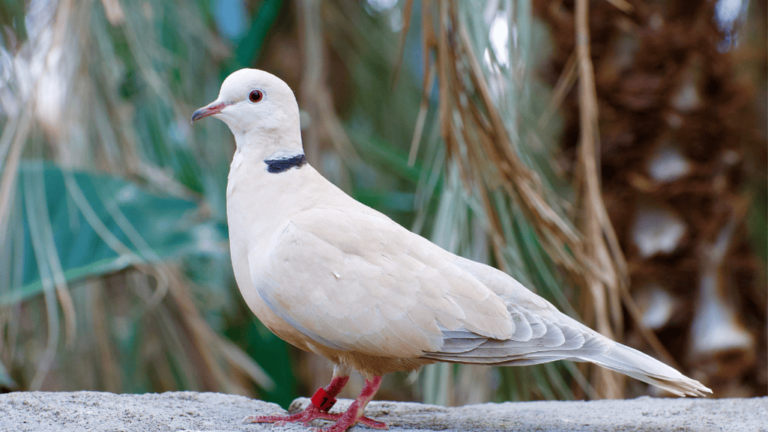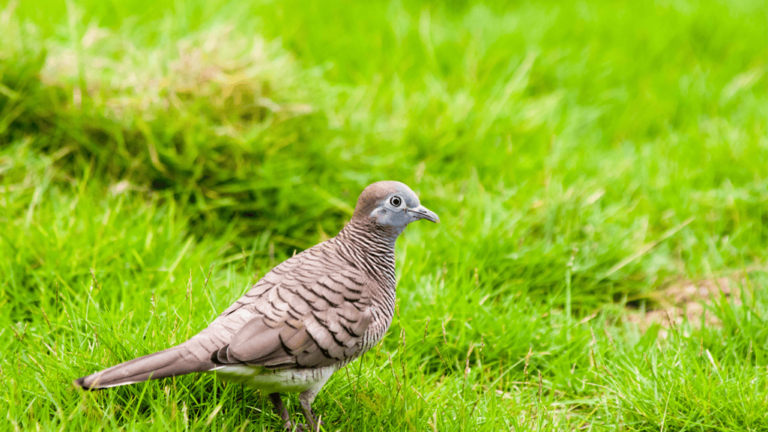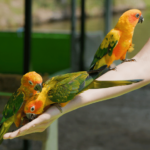The Eurasian collared dove, known as Streptopelia decaocto, is now common in North American gardens. It comes from subtropical Asia but has adapted well to city life. Bird lovers often see these doves with their black collars on feeders or in nearby trees.
First seen in Maine in 2013, these doves have quickly spread across the continent. They have a 51cm wingspan and weigh about 200g. These birds have made a home in our cities and suburbs. Their ability to live in human-made environments has led to a big increase in numbers. In the UK, there are now about 990,000 breeding pairs.
Key Takeaways
- Eurasian collared doves are non-native to North America
- They have a distinctive black collar and pale grey plumage
- These doves adapt well to urban and suburban environments
- They have an average lifespan of 3 years, but can live up to 17 years
- Collared doves can have 2 to 5 clutches per breeding season
- Their population has spread rapidly since introduction to North America
Introduction to the Eurasian Collared Dove
The Eurasian Collared Dove is now a common bird in many places around the world. It has traveled from its original home to new lands, showing how birds migrate and adapt. This bird’s story is a great example of how species can spread and thrive in new areas.
Origin and Spread
Originally from Turkey and the Balkans, the Eurasian Collared Dove started moving west in the early 1900s. By the 1950s, it had reached Western Europe, including the UK. Then, it moved even further, reaching the Bahamas in the 1970s.
By the 1980s, it had spread to Florida and quickly covered most of North America. This shows how fast these birds can adapt and spread out.
Physical Characteristics
Eurasian Collared Doves are bigger than Mourning Doves but smaller than Rock Pigeons. They have a light brown to gray-buff color and broad white patches on their tail. A unique black crescent mark is on their neck, giving them their name.
When they fly, you can see their wide, slightly rounded wings with darker tips.
Scientific Classification
The name Streptopelia decaocto for this species tells us a lot about it. “Streptopelia” means “collar” and “dove” in Greek. “Decaocto” comes from a myth about how it was made.
| Kingdom | Phylum | Class | Order | Family | Genus | Species |
|---|---|---|---|---|---|---|
| Animalia | Chordata | Aves | Columbiformes | Columbidae | Streptopelia | S. decaocto |
Knowing how to identify these doves helps us understand their growth and effect on new areas. They have thrived in cities and at bird feeders, playing a big part in their North American success.
Historical Range Expansion
The Eurasian collared dove’s expansion is a fascinating story of bird migration. This exotic bird has moved quickly across continents. It shows how well it can adapt and live in new places.
These doves started in Turkey and the Balkans. They moved across Europe, reaching China and Morocco. In the 1970s, they were brought to the Bahamas, starting their journey to North America.
By the early 1980s, they reached South Florida. This was the beginning of their move across the continent.
Their expansion is amazing. In just 20 years, they covered the whole United States. By 2001, they were seen in California. And by 2005, birders in Idaho first saw them.
Last year, the Great Backyard Bird Count in Idaho found 719 doves. This shows how well they have settled.
| Year | Milestone |
|---|---|
| 1970s | Introduction to Bahamas |
| Early 1980s | Reached South Florida |
| 2001 | Spotted in California |
| 2005 | First recorded in Idaho |
This expansion isn’t just in North America. In Asia, Eurasian collared doves are also moving into new countries every year. They like living near homes and farms, which helps them spread fast. They are moving faster than many native birds into changed landscapes.
Eurasian Collared Dove Identification
Identifying doves can be hard, but the Eurasian collared dove is easy to spot. It has unique features that stand out. This bird is a common visitor to gardens.
Size and Shape
The Eurasian collared dove is a medium-sized bird. It measures about 32 cm from beak to tail. It weighs between 125 to 240 grams.
These doves have a plump body with a small head. They also have a long, squared tail.
Plumage and Coloration
The Eurasian collared dove has pale brown feathers all over its body. Its wings have slightly darker tips for a subtle contrast. The tail feathers are gray with white edges, visible when flying.
Distinctive Collar Marking
The bird’s most recognizable feature is its black collar on the neck. This half-moon shaped marking gives it its name. It’s a clear identifier when comparing to other doves.
The bird’s eyes are dark, and it has reddish feet. These add to its unique look.
| Feature | Description |
|---|---|
| Length | 32 cm |
| Weight | 125-240 grams |
| Body color | Pale gray-brown |
| Distinctive mark | Black collar on neck |
Habitat Preferences and Adaptation
Eurasian collared doves are amazing at adapting to different environments. They live in both cities and the countryside. These birds help make cities more diverse by fitting right into our changed landscapes. They are now common visitors in many backyards.
They like open areas with a few trees, so gardens and parks are perfect for them. To draw these doves in, plant tall trees and shrubs. They need these for shelter and places to nest. A study by Havlíček et al. (2021) showed how important green spaces are for these birds in cities.
These doves have special ways of finding food. They mostly eat seeds and prefer to forage on the ground. To help them, put out a feeder that’s easy for them to reach. Use a mix of millet, sunflower seeds, and cracked corn. This is backed by research by Poling and Hayslette (2006) on what these birds eat.
| Habitat Feature | Attraction Method | Benefit |
|---|---|---|
| Tall Trees | Plant diverse tree species | Nesting sites and shelter |
| Water Source | Install shallow birdbath | Hydration and plumage maintenance |
| Food Supply | Offer seed mix in flat feeders | Meets dietary preferences |
| Open Spaces | Maintain lawn areas | Supports ground-feeding behavior |
El-Mansi et al. (2021) studied the Eurasian collared doves’ digestive system. They found that these birds can live in many places because of their unique body traits. This helps them move into new areas and grow their numbers.
Breeding Behavior and Nesting Habits
Eurasian Collared Doves have interesting nesting habits that help them spread across North America. They live in many places, even cities, which has made their numbers grow fast.
Mating Patterns
These doves are monogamous, staying with one partner for life. They start breeding in March, but can do so all year in mild places. This has led to a big increase in their numbers, especially since they arrived in Florida in the 1980s.
Nest Construction
Building nests is simple for these doves. They use twigs, debris, and dry grass. Most nests have more twigs, debris, and grass. They pick trees, shrubs, or even buildings like gutters for their nests, showing they can live in cities too.
Breeding Season and Clutch Size
Eurasian Collared Doves breed a lot. Females lay two eggs at a time and can have up to 6 broods a year. They usually lay 1 to 2 eggs, with an average of 1.7 per nest. Both parents take turns incubating the eggs for about 14.5 days. The chicks leave the nest after 17 days.
This breeding helps their numbers grow fast. There are now about 85 million of them worldwide. For more info on parrot breeding, check out the Vernal Hanging Parrot.
Diet and Feeding Habits
Eurasian Collared Doves eat a wide variety of foods, showing how adaptable they are. They love seeds and grains, which brings them to bird feeders in gardens and parks. They’re especially fond of sunflower hearts and seed mixes.
But they’re not just seed eaters. They also enjoy berries, small insects, and worms. This variety in their diet helps them thrive in different places.
Some farmers see these doves as pests because they eat new crops. Yet, they play a key role in spreading seeds and controlling pests. Knowing how they eat helps with bird feeding and farm management.
| Food Type | Preference Level | Availability |
|---|---|---|
| Seeds and Grains | High | Year-round |
| Berries | Medium | Seasonal |
| Insects | Low | Opportunistic |
| Worms | Low | Opportunistic |
To get these doves to visit your yard, try offering their favorite foods. Put seed mixes on the ground or on low platforms. They like to eat at ground level. Remember, feeding birds responsibly helps keep ecosystems healthy.
Eurasian Collared Dove in North America
The Eurasian collared dove first came to North America in 1974, in the Bahamas. It quickly spread across the continent, showing how fast it could grow. By 2004-2005, it was found in 32 states and 4 Canadian provinces, according to the Audubon Christmas Bird Count.
Introduction and Spread
It took about 12 years for the dove to reach North America before it went to Africa in 1986. Its fast spread was similar to its move in Europe, as noted by James Fisher in 1953. These adaptable birds can have 3 to 6 broods a year, often in palm trees.
Impact on Native Species
The Eurasian collared dove’s growth is affecting native birds. Winter counts show more doves while mourning dove numbers fell from 2003 to 2017. This change in numbers raises worries about competition for food and space.
Current Population Status
Although their numbers have dropped in some places since 2005, they’re still spreading. They were seen in Anchorage, Alaska in 2015 and are becoming more common in Mexico. Experts think they will keep moving north into Canada.
| Characteristic | Data |
|---|---|
| Length | 12.5 inches |
| North American subspecies | 2 |
| Breeding habits | 3-6 broods yearly |
| Legal status | Nuisance/unprotected in most states |
Conservation Status and Challenges
The Eurasian Collared Dove is a key species in biodiversity conservation. It has spread widely across North America, but conservation efforts are still minimal. The International Union for Conservation of Nature (IUCN) has listed it as “Least Concern” globally. In Canada, it’s seen as an “Exotic Wild Species” with fewer than 5,000 adults.
Its fast growth is clear from surveys like the Breeding Bird Survey and Christmas Bird Count. Since arriving in the Bahamas in the 1970s, it has quickly moved into the United States and Canada. It thrives in cities and suburbs, often using feeders and buildings for homes.
Even though it’s not yet seen as a pest, its effect on native birds is still unknown. Experts are looking into how it interacts with local ecosystems. The Bird Conservation Region Strategies in Canada don’t highlight this dove as a priority, showing it’s not native.
Future studies will explore its role in North American ecosystems and its impact on native birds. This research is key to creating effective management plans. It will help balance conservation with the dove’s invasive success.
Interactions with Humans and Urban Environments
Eurasian Collared Doves are now common in cities, adjusting well to living near people. They love cities and towns, becoming a big part of urban wildlife. These birds and humans have interesting interactions and challenges.
Garden Visitation
These doves often visit gardens, adding to the fun of backyard birding. A study in San Miguel de Cozumel found them at 94% of sites, with about 6.8 birds per hectare. This makes them a common sight for bird lovers.
Adaptability to Human Structures
These doves adapt well to buildings made by humans. Studies show they like areas with more trees and tall buildings. They often nest in human-made places, showing they can live in cities.
Potential Conflicts with Agriculture
While people like these doves, they can be a problem for farmers. Farmers use kind ways to control dove numbers. Since the 1970s, these birds have spread fast, showing we need smart ways to manage them.
| Aspect | Impact | Management Approach |
|---|---|---|
| Urban Presence | High (94% of survey sites) | Urban planning considerations |
| Agricultural Impact | Moderate to High | Humane deterrents, crop protection |
| Native Species Interaction | Minimal in some areas (e.g., Florida) | Ongoing monitoring through citizen-science |
Conclusion
The Eurasian Collared Dove’s story shows how nature can adapt and thrive. It moved from Asia to become a common sight in gardens and cities around the globe. Its fast growth in North America teaches us a lot about wildlife conservation and nature studies.
Bird watchers have seen the dove’s numbers grow. In Central Alberta, there were just nine in 2005 but 20 by 2016. This shows how well it has adapted to new places. Studies also show that these doves don’t harm native dove populations as much as we thought.
Living with these doves means finding ways to coexist. We can do this by feeding them right and managing their habitats. Learning from the Eurasian Collared Dove helps us understand how species adapt and how to protect nature in our changing world.


